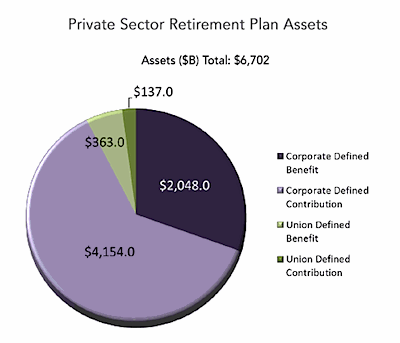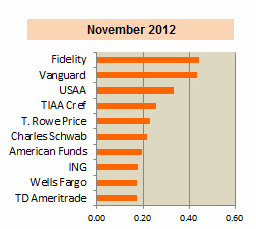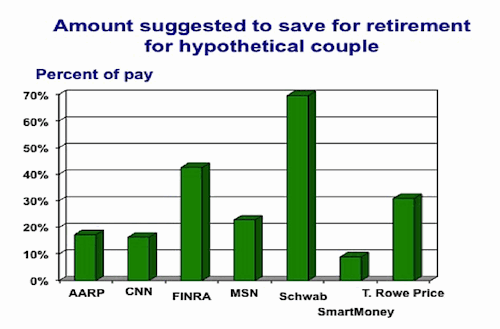Income projections have small but significant effect on participant savings rates
Sponsors and providers of workplace retirement plans have been encouraged to provide participants with quarterly estimates of the amount of monthly income each might receive during retirement based on their current or projected account balances.
Three researchers from Stanford and the University of Minnesota decided to test participants in the university’s retirement plans to see if such information actually produces higher savings rates and, by extension, greater financial security in retirement.
Their results, published by the Center for Retirement Research at Boston College, showed that income projections changed the savings behavior of only a small percentage of people, but that those people increased their savings rate by $1,150 a year on average.
The researchers divided 17,000 University of Minnesota employees into four groups—a control group that received no special education and three treatment groups. Each treatment group received one of these brochures:
- A “planning treatment” brochure with general information on saving for retirement and a step-by-step guide for signing up or changing contributions to a Voluntary Retirement Plan (VRP).
- A “balance treatment” brochure with added age-specific projections of how hypothetical additional contributions to the VRP would translate into additional balances at retirement.
- An “income treatment” brochure with added age-specific projections of how the additional contributions to the VRP would increase retirement income.
Compared to the national population, the university workers were more educated and had more retirement savings. They are covered by Social Security and by one of two generous employer plans. They can also contribute to a tax-deferred Voluntary Retirement Plan (VRP).
The results show that the “income treatment” had a small but significant effect on savings rates. Compared to the control group, members of the income group were 1.2 percentage points more likely to change their contributions during the six-month period following receipt of the brochures – 5.3% vs. 4.1%.
Members of the income group as a whole increased their retirement saving, on average, by just $85 more per person than the control group. But, considering only those who made a change, members of the “income group” increased their savings by $1,150 more per year than those in the control group.
Relative to the control group, individuals in the other two treatment groups – the “planning group” and “balance group” – were also more likely to change their VRP contributions but did not show a statistically significant increase in the amount of saving.
“It was not the income projections alone, but the combined effect of providing retirement planning information along with the balance and income projections that encouraged the increase in saving for those in the income group,” the researchers wrote.
The effect of the income treatment on retirement saving was significantly reduced among people who had difficulty in paying bills, who said they live “pretty much for today,” and who were inclined to procrastinate. The effect was enhanced among people who described themselves as “good at following through.” Intelligence and financial literacy scores had no measurable impact on savings behavior.
The authors of the study were Gopi Shah Goda, a senior research scholar at the Stanford Institute for Economic Policy Research, and Colleen Flaherty Manchester and Aaron Sojourner, who are assistant professors at the Center for Human Resources & Labor Studies, a part of University of Minnesota’s Carlson School of Management.
New York Life’s operating earnings up 18.4% in 2012
New York Life announced a record operating earnings of $1.6 billion in 2012, an increase of 18.4% over 2011. Surplus and asset valuation reserve in 2012 rose to a record $19.6 billion, the company said in a release. Combined life insurance face value was $816 billion, also a record.
Individual recurring premium life insurance sales through the company’s 12,000 agents grew 4% over 2011, while annuity sales through agents were up 9%. Sales of long-term mutual funds through agents rose 34% over the prior year. Assets under management for New York Life increased 12.6% to $381 billion.
In 2012, $8.1 billion in benefits and dividends was paid out to the company’s life insurance policyholders and annuity contract owners.
On the annuity side, New York Life continued to lead the industry in providing guaranteed lifetime income, with a 28% market share in fixed immediate annuities, according to LIMRA.
Morningstar webinar to focus on variable annuities
Morningstar will sponsor a free webinar next week to review the past year in the VA industry, highlighting product development and distribution as well as trends and expectations for 2013.
The presenters will be Kevin Lofreddi, vice president, Morningstar, and John McCarthy, product manager, Morningstar. The webinar will take place at 3:30 p.m. Central (4:30 p.m. Eastern) on April 11.
Nationwide to acquire 17 HighMark Capital funds
Nationwide Financial has agreed to acquire 17 equity and bond mutual funds from HighMark Capital Management, Inc.. The transaction is expected to bring Nationwide’s fund business about $3.6 billion in new assets. Terms weren’t disclosed.
The transaction, which has been approved by the boards of both mutual fund complexes, is expected to close by the end of the third quarter, pending regulatory and shareholder approvals. Afterwards, Nationwide’s mutual fund business is expected to have about $51 billion under management.
HighMark Capital Management, a unit of Union Bank, N.A., will become the subadviser for the successors to the nine funds that it currently manages in the form of nine new Nationwide Funds. Eight of the 17 mutual funds are subadvised by three other asset managers: Bailard, Inc., Geneva Capital Management Ltd, and Ziegler Lotsoff Capital Management, LLC. Those relationships will continue.
HighMark Capital Management will focus on managing institutional and high net worth assets for its wealth management and separately managed institutional businesses, where it will oversee more than $15 billion in client assets.
Nationwide Financial engaged Cambridge International Partners Inc. as its financial advisor and Stradley Ronon Stevens & Young, LLP as its legal counsel. Berkshire Capital Securities LLC acted as the financial advisor and Bingham McCutchen LLP as the legal advisor for HighMark Capital Management and Union Bank.
© 2013 RIJ Publishing LLC. All rights reserved.


 Investors are taking more risk with their retirement funds than they did in 2008, however, when 401(k) plan participants held just 29% of their assets in equities and 13% in company stock.
Investors are taking more risk with their retirement funds than they did in 2008, however, when 401(k) plan participants held just 29% of their assets in equities and 13% in company stock. Other insights from the report include:
Other insights from the report include:
















